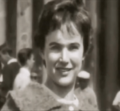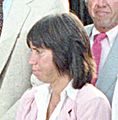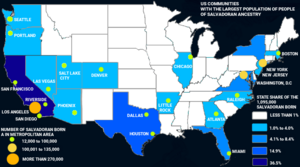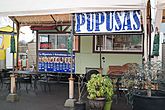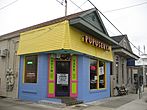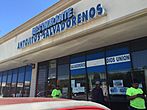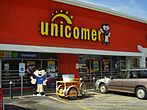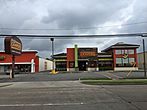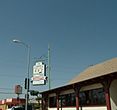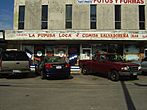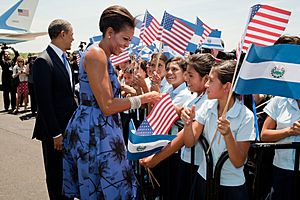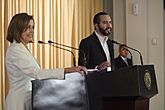Salvadoran Americans facts for kids
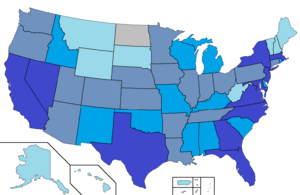
Salvadorans by state
|
|
| Total population | |
|---|---|
| 2,473,947 (2021 American Community Survey) 0.75% of total U.S. population, 2021 |
|
| Regions with significant populations | |
| Greater Los Angeles, Houston, San Francisco Bay Area, Maryland, Washington, D.C., Dallas, New York City, Long Island, New Jersey, Greater Boston, Miami, Northern Virginia, Chicago, Atlanta, Charlotte, Las Vegas Valley, Fayetteville–Springdale–Rogers metropolitan area, San Diego, Philadelphia | |
| Languages | |
| Spanish, English | |
| Religion | |
| Christianity (mostly Catholic, significantly Protestant) | |
| Related ethnic groups | |
| Spanish Americans |
Salvadoran Americans are people in the United States who have full or partial family roots from El Salvador. In 2021, there were over 2.4 million Salvadoran Americans. This makes them the third-largest Hispanic group in the U.S. by where their families came from.
Salvadorans are the biggest group of people from Central America living in the U.S. The largest communities are in big cities like Los Angeles and Washington, D.C.. These communities started growing in the 1970s. You can also find many Salvadorans in California (32%), Texas (15%), and New York (9%).
Contents
- What is a Salvadoran?
- A Look at Salvadoran American History
- Language: Spanish and English
- Religious Beliefs
- Where Do Salvadoran Americans Live?
- Culture and Community Life
- Salvadoran Americans in Politics
- Connections Between Salvadoran Americans and El Salvador
- El Salvador and United States Relations
- See also
What is a Salvadoran?
The most common way to call someone from El Salvador or with Salvadoran roots is "Salvadoran." You might also hear "Salvadorian" or "Salvadorean" in English. These words sound more like the Spanish word Salvadoreño.
People from El Salvador also often call themselves "Central American." This is because El Salvador is in the middle of the Americas. This term shows the strong connection Central American countries have had since they became independent. They have even tried to unite as one country several times in the past.
Fun Nicknames for Salvadorans
"Salvi" is a friendly, informal nickname for Salvadoran people and their culture. It's mostly used by Salvadorans who were born outside El Salvador, especially in the U.S. This nickname came from the first generation of Salvadoran Americans. They were born in the U.S. to parents who came here in the 1980s. "Salvi" is seen as a very positive and loving term.
In El Salvador, people often use the term "Guanaco" or "Guanaca." This is also a friendly nickname and is not considered offensive there.
A Look at Salvadoran American History
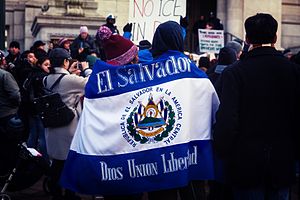
Before the El Salvador Civil War (1979–1992), some Salvadorans came to the U.S. in the early 1900s. They mostly settled in San Francisco and worked in shipyards. Many came for better jobs because El Salvador faced economic problems. In the 1960s and 1970s, many women came and found work as housekeepers or in childcare.
During the 12-year civil war, about 1 million Salvadorans left their country. About half of them came to the United States. In recent years, more Salvadorans have moved to the U.S. because of social problems, political issues, and increased violence.
More People Arrive (1980s-Today)
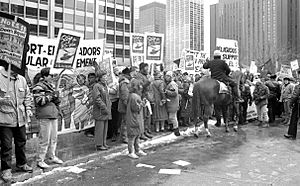
The number of Salvadorans coming to the U.S. grew a lot during the Salvadoran Civil War. Many people sought safety from the fighting. Some experts believe that economic problems caused by the war were a big reason for people to leave. Before 1960, fewer than 10,000 Salvadorans lived in the U.S. After the war started, between 500,000 and 1 million came.
Many Salvadorans who came without legal papers applied for asylum or work permits. This helped them to live legally in the U.S. Many settled in Los Angeles, which now has the largest Salvadoran population. A large number also moved to Washington, D.C.. By 1989, about 150,000 Salvadorans lived there.
Wealthy Salvadorans also found safety in the U.S. They moved to places like Coral Gables and Key Biscayne in Miami. Many planned to return home after the war ended.
The biggest wave of Salvadoran immigration happened because of the civil war in the 1980s. About 20% to 30% of El Salvador's population left the country. Around 50% of those who left came to the U.S. This made Salvadoran Americans the third-largest Hispanic American group.
The number of Salvadoran immigrants kept growing in the 1990s and 2000s. This was due to families reuniting and new arrivals escaping natural disasters. These included earthquakes in 2001 and Hurricane Mitch. Gang violence also made El Salvador a dangerous place. This caused more people to seek safety in the U.S. By 2008, about 1.1 million Salvadoran immigrants lived in the United States.
Another reason for migration was the "Temporary Protected Status" (TPS) program. This program allowed Salvadorans to live and work legally in the U.S. after natural disasters. When there were talks about ending TPS, many families worried they would lose their jobs or be sent back to El Salvador.
| Years | Number of Salvadorans |
|---|---|
| 1931–1940 | 673 |
| 1941–1950 | 5,132 |
| 1951–1960 | 5,895 |
| 1961–1970 | 14,992 |
| 1971–1980 | 34,436 |
| 1981–1990 | 213,539 |
| 1991–2000 | 215,798 |
Famous Salvadoran Americans
-
Alicia Nash was a Salvadoran-American physicist.
-
Christy Turlington is an American supermodel. Her mother is from El Salvador.
-
Monica Lewinsky's father was born in El Salvador.
-
Francisco Caceres is a TV host and producer.
-
Allison Iraheta is a singer.
Language: Spanish and English
In the U.S., Salvadorans speak both English and Spanish. Newer immigrants and older people often speak only Spanish. Younger generations, whose parents immigrated, learn Spanish first but become fluent in English when they start school. In 2004, only 5.2% of Salvadorans spoke only English at home.
Salvadoran Spanish is a common type of Spanish spoken in the U.S. It uses the old pronoun "vos" instead of "tú" (both mean "you"). This makes Salvadorans the largest group of "voseo" Spanish speakers in the country. In Washington D.C., Salvadoran Spanish is the most common Spanish dialect. In Los Angeles, it's the second most common, after Mexican Spanish. Salvadoran Spanish also includes many words from old Native American languages like Lenca and Pipil language.
Religious Beliefs
Most Salvadorans are Christian. Traditionally, they are Roman Catholics. However, since the civil war, more Salvadorans have become Evangelicals or other Protestant faiths. There is also a small Jewish community, mostly made up of business owners. Some Salvadoran Americans have also joined the Mormon or Jehovah's Witness faiths. Younger Salvadoran Americans are less likely to practice religion than their parents.
Where Do Salvadoran Americans Live?
Many Salvadoran Americans live in the Greater Los Angeles area, including Orange County, California and the Inland Empire. They also live in San Diego and the Washington metropolitan area. This includes Washington, D.C., Maryland, and Northern Virginia. The Washington, D.C. area is the only place where Salvadorans are the largest Hispanic group. They are most common in the suburbs of Northern Virginia and Maryland. In Washington D.C. itself, 32% of the Hispanic population is Salvadoran.
You can also find many Salvadorans in Texas, especially in Houston, Austin, Dallas, and Fort Worth. After Hurricane Katrina in 2005, many moved to New Orleans. Other areas include the San Francisco Bay Area and the New York City area. In Massachusetts, many live in Greater Boston cities like Chelsea and Somerville.
Recent information shows that more Salvadorans now live on Long Island than Puerto Ricans. Nearly 100,000 Salvadorans live there, making them the largest Hispanic group in that area.
States with Many Salvadorans
| State | Salvadoran Population (2019 Census) |
Percent |
|---|---|---|
| 4,713 | 0.1% | |
| 938 | 0.1% | |
| 19,556 | 0.3% | |
| 25,031 | 0.8% | |
| 731,873 | 1.9% | |
| 24,375 | 0.4% | |
| 6,635 | 0.2% | |
| 1,085 | 0.1% | |
| 19,984 | 2.8% | |
| 78,578 | 0.4% | |
| 31,888 | 0.3% | |
| 862 | 0.1% | |
| 1,689 | 0.1% | |
| 23,495 | 0.2% | |
| 12,562 | 0.2% | |
| 8,905 | 0.3% | |
| 7,822 | 0.3% | |
| 5,038 | 0.1% | |
| 9,207 | 0.2% | |
| 746 | 0.1% | |
| 198,863 | 3.3% | |
| 62,964 | 0.9% | |
| 6,522 | 0.1% | |
| 10,599 | 0.2% | |
| 1,303 | 0.0% | |
| 5,841 | 0.1% | |
| 140 | 0.0% | |
| 6,781 | 0.4% | |
| 40,576 | 1.3% | |
| 1,340 | 0.1% | |
| 75,927 | 0.9% | |
| 2,644 | 0.1% | |
| 181,174 | 0.9% | |
| 61,618 | 0.6% | |
| 73 | 0.0% | |
| 13,528 | 0.1% | |
| 5,397 | 0.1% | |
| 7,445 | 0.2% | |
| 14,082 | 0.1% | |
| 2,662 | 0.3% | |
| 5,137 | 0.1% | |
| 780 | 0.1% | |
| 12,740 | 0.2% | |
| 363,762 | 1.3% | |
| 10,767 | 0.3% | |
| 116 | 0.0% | |
| 179,437 | 2.1% | |
| 18,398 | 0.2% | |
| 893 | 0.0% | |
| 2,308 | 0.0% | |
| 198 | 0.0% | |
| Total U.S. Salvadoran Population | 2,311,574 | 0.7% |
Major Cities with Salvadoran Communities
The largest Salvadoran populations are found in these metropolitan areas (2021 Census):
- Los Angeles-Long Beach-Anaheim, CA Metro Area – 469,230
- Washington-Arlington-Alexandria, DC-VA-MD-WV Metro Area – 315,279
- New York-Newark-Jersey City, NY-NJ-PA Metro Area – 250,776
- Houston-The Woodlands-Sugar Land, TX Metro Area – 206,799
- Dallas-Fort Worth-Arlington, TX Metro Area – 96,482
- San Francisco-Oakland-Berkeley, CA Metro Area – 96,160
- Riverside-San Bernardino-Ontario, CA Metro Area – 64,420
- Boston-Cambridge-Newton, MA-NH Metro Area – 60,328
- Miami-Fort Lauderdale-Pompano Beach, FL Metro Area – 44,721
- Las Vegas-Henderson-Paradise, NV Metro Area – 35,747
Culture and Community Life
-
Pupuseria La Casita at Nationals Park Stadium for Washington, D.C.'s baseball team
-
Unicomer in Gulfton, Houston, is a multinational retailing group headquartered in San Salvador.
In 2004, about 40% of Salvadorans and Salvadoran Americans in the U.S. had a high school diploma. About 10% had a bachelor's degree. The average income for Salvadorans was $40,000. Many Salvadorans who came to the Washington D.C. area in the 1980s are now business owners. They often own construction, restaurant, or cleaning businesses.
Many Salvadorans in the U.S. live in close-knit communities. They often live with other people from El Salvador, sometimes even from their same hometown. Older immigrants might live in the U.S. for many years without learning English.
Even though many Salvadorans came to the U.S. for safety, they are slowly becoming more Americanized. Younger generations born in the U.S. are learning more about their Salvadoran heritage. They are also becoming more active in helping El Salvador.
Organizations like the Central America Resource Center (CARECEN) help Salvadoran communities. They offer services like education, translation, healthcare, and childcare.
In areas with many Salvadorans, festivals celebrate their culture. In Los Angeles, several Salvadoran events happen in August. In Maryland and Virginia, there are annual Salvadoran-American Festivals. Pupusas, the national dish of El Salvador, are very popular in the U.S. Some restaurants even make Americanized pupusas with new ingredients. New York State and Maryland have even declared August 6 and August 5 as "Day of the Salvadoran American."
Salvadoran Americans in Politics
Salvadorans are becoming more involved in local and state politics in the U.S. For example, Wendy Carrillo serves in the California State Assembly. She represents parts of Los Angeles. In the Washington D.C. area, several Salvadoran American politicians hold office. These include Walter Tejada in Arlington County, Virginia, and Delegates Ana Sol Gutierrez and Victor R. Ramirez in Maryland.
On Long Island, Salvadorans are also seeking political roles. Monica Martinez was elected to the Suffolk County legislative District in 2013. Her brother, Antonio Martinez, was the first Salvadoran elected to office on Long Island.
In 2020, Ricky Hurtado was elected to the North Carolina General Assembly. He became the first Hispanic Democrat to serve there.
Salvadoran Americans have also played a big role in laws about immigration. They have spoken out and organized to help Salvadoran refugees get "Temporary Protected Status" (TPS). This status helps them live and work in the U.S. legally.
Many Salvadorans have also joined labor unions. They have fought for workers' rights in the U.S., just as some did in El Salvador. For example, Salvadoran union members were very active in a janitors' strike in Los Angeles in 1990.
When Salvadorans first arrived in the U.S. around 1990, they were split between supporting Democrats and Republicans. But since President Obama, many Salvadorans tend to vote for Democrats. This is partly because of promises to help undocumented immigrants. However, in recent elections, some Salvadorans have also voted for Republican candidates.
Connections Between Salvadoran Americans and El Salvador
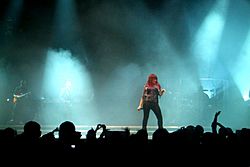
Most Salvadorans born in the U.S. are not very active in El Salvador's politics. Their organizations in the U.S. usually focus on helping immigrants with relief and jobs. They often want to move past the difficult political history of El Salvador.
However, some groups have worked to keep ties with El Salvador. They have spoken out on political issues there. For example, during the 2004 Salvadoran presidential elections, some groups rallied to ensure the U.S. government stayed neutral.
Salvadorans living in the U.S. cannot vote in El Salvador's elections. Many believe that if they could vote, it might change election outcomes in El Salvador.
As more Salvadorans become U.S. citizens, they will likely play a bigger role in local and regional politics. Their economic contributions also mean they will likely have more influence in El Salvador.
El Salvador and United States Relations
-
Speaker Nancy Pelosi meets with Salvadoran President Nayib Bukele on August 10, 2019.
-
U.S. Secretary of State Mike Pompeo participates in a signing ceremony with Salvadoran President Nayib Bukele, in San Salvador, El Salvador, July 21, 2019.
The United States and El Salvador have a long history together. The U.S. was involved in the Salvadoran Civil War and in some elections.
In 2011, President Obama and President Funes of El Salvador announced a "Partnership for Growth." This plan aimed to help El Salvador's economy grow. They focused on reducing crime and improving productivity.
Recent elections in El Salvador have seen a shift in power. Despite this, the U.S. continues to have strong ties with El Salvador. This shows that the U.S. accepts the new government.
El Salvador's cooperation with the U.S. has brought benefits. Salvadorans in the U.S. have been able to receive "Temporary Protection Status" (TPS) since 1990. This allows them to work and protects them from being sent back to El Salvador.
The money sent home by Salvadorans in the U.S. is very important to El Salvador's economy. In 2017, over $5 billion was sent back. This money helps El Salvador's economy a lot. This means El Salvador needs to keep good relations with the U.S.
The U.S. and El Salvador have a close relationship. The U.S. helps El Salvador strengthen its democracy, laws, and police. El Salvador has also helped the U.S. in fighting terrorism. They have sent troops to places like Iraq and Afghanistan for humanitarian and training missions.
More than 19,000 American citizens live and work in El Salvador. Most are business people and their families. The U.S. Embassy in El Salvador helps these citizens.
See also
 In Spanish: Inmigración salvadoreña en los Estados Unidos para niños
In Spanish: Inmigración salvadoreña en los Estados Unidos para niños
- Salvadoran Mexicans
- Salvadoran Australians
- History of the Central Americans in Houston
- El Salvador–United States relations
- Salvadoran diaspora in Los Angeles


